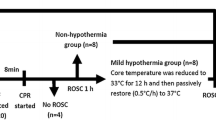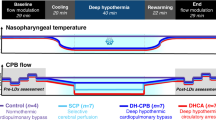Abstract
Objective: We studied the effect of deep hypothermia on cerebral hemodynamics during selective cerebral perfusion with systemic circulatory arrest.Methods: Ten anesthesized pigs were placed on cardiopulmonary bypass and cooled to a rectal temperature of 22°C (n=5) or 15°C (n=5). During selective cerebral perfusion, the descending aorta was clamped and perfusion of the lower body was discontinued. As the pump flow was changed, we monitored the perfusion pressure, local cerebral blood flow, and local cerebral oxygenation using laser Doppler flowmetry and near-infrared spectroscopy. We also measured the free flow of the left internal thoracic artery during selective cerebral perfusion.Results: Perfusion pressure and local cerebral blood flow decreased as the pump flow decreased. Oxygenated and deoxygenated hemoglobin in cerebral tissue remained unchanged at a perfusion flow of 10 ml/kg/min, whereas oxygenated hemoglobin decreased and deoxygenated hemoglobin increased progressively and reciprocally as the pump flow decreased. The pump flow for maintaining perfusion pressure above 35 mmHg with stabilized local cerebral oxygenation was significantly higher at 15°C than at 22°C. The internal thoracic artery free flow was higher at 15°C than at 22°C.Conclusions: Selective hypothermic cerebral perfusion with systemic circulatory arrest produces an extracranial shunt through the internal thoracic artery, especially under deep hypothermia. Our data suggests that selective cerebral perfusion during deep hypothermia is best managed by perfusion pressure control rather than by flow control.
Similar content being viewed by others
References
Svensson LG, Crawford ES, Hess KR, Coselli JS, Raskin S, Shenaq SA, et al. Deep hypothermia with circulatory arrest: determinant of stroke and early mortality in 656 patients. J Thorac Cardiovasc Surg. 1993; 106: 19–31.
Ergin MA, Uysal S, Reich DL, Apaydin A, Lansman SL, McCullough JN, et al. Temporary neurological dysfunction after deep hypothermic circulatory arrest: a clinical marker of long-term functional deficit. Ann Thorac Surg. 1999; 67: 1887–90.
Griepp RB, Stinson EB, Hollingsworth JF, Buehler D. Prosthetic replacement of the aortic arch. J Thorac Cardiovasc Surg 1975; 70: 1051–63.
Ergin MA, Galla JD, Lansman SL, Quintana C, Bodian C, Griepp RB. Hypothermic circulatory arrest in operations on the thoracic aorta: determinant of operative mortality and neurologic outcome. J Thorac Cardiovasc Surg. 1994; 107: 788–99.
Newburger JW, Jonas RA, Wernovsky G, Wypij D, Hickey PR, Kuban KC, et al. A comparison of the perioperative neurologic effects of hypothermic circulatory arrest versus low-flow cardiopulmonary bypass in infant heart surgery. N Engl J Med 1993; 329: 1057–64.
Treasure T, Naftel DC, Conger KA, Garcia JH, Kirklin JW, Blackstone EH. The effect of hypothermic circulatory arrest time on cerebral function, morphology, and biochemistry: an experimental study. J Thorac Cardiovasc Surg 1983; 86: 761–70.
Frist WH, Baldwin JC, Stanes VA, Stinson EB, Oyer PE, Miller DC, et al. A reconstruction of cerebral perfusion in aortic arch replacement. Ann Thorac Surg 1986; 42: 273–81.
Bloodwell RD, Hallman GL, Cooley DA. Total replacement of the aortic arch and the “subclavian steal” phenomenon. Ann Thorac Surg 1968; 5: 236–45.
Matsuda H, Nakano S, Shirakura R, Matsuwaka R, Ohkubo N, Ohtani M, et al. Surgery for aortic arch aneurysm with selective cerebral perfusion and hypothermic cardiopulmonary bypass. Circulation 1989; 80: (Suppl I): I-243.
Bachet J, Guilmet D, Goudot B, Dreyfus GD, Delentdecker P, Brodaty D, et al. Aiitegrade cerebral perfusion with cold blood: a 13-year experience. Ann Thorac Surg 1999; 67: 1874–8.
Sakurada T, Kazui T, Tanaka H, Komatsu S. Experimental study of safe limits of retrograde cerebral perfusion (Eng abstr). J Jpn Assn Thorac Surg 1996; 44: 1860–6.
Kuwabara M, Nakajima N, Andou M, Adachi M, Uemura S, Kasegawa H, et al. A study on the methods of selective cerebral perfusion on aortic arch replacement (Eng abstr). J Jpn Assn Thorac Surg 1988; 36: 466–71.
Greeley WJ, Ungerleider RM, Smith LR, Reves JG. The effects of deep hypothermic cardiopulmonary bypass and total circulatory arrest on cerebral blood flow in infants and children. J Thorac Cardivasc Surg 1989; 97: 737–45.
Greeley WJ, Kern FH, Ungerleider RM, Boyd JL, Quill T, Smith LR, et al. The effect of hypothermic cardiopulmonary bypass and total circulatory arrest on cerebral metabolism, in neonates, infants, and children. J Thorac Cardivasc, Surg 1991; 101: 783–94.
Kern FH, Ungerleider RM, Reves JG, Quill T, Smith LR, Baldwin B, et al. Effect of altering pump flow rate on cerebral blood flow and metabolism in infants and children. Ann Thorac Surg 1993; 56: 1366–72.
Tanaka J, Shiki K, Asou T, Yasui H, Tokunaga K. Cerebral autoregulation during deep hypothermic nonpulsatile cardiopulmonary bypass with selective cerebral perfusion in dogs. J Thorac Cardiovasc Surg 1988; 95: 124–32.
Swain JA, McDonald TJ, Griffith PK, Balaban RS, Clark RE, Ceckler T. Low-flow hypothermic cardiopulmonary bypass protects the brain. J Thorac Cardiovasc Surg 1991; 102: 76–83.
Ferrari M, Wilson DA, Hanley DF, Hartmann JF, Rogers MC, Traystman RJ. Noninvasive determination of hemoglobin saturation in dogs by derivative near-infrared spectroscopy. Am J Physiol 1989; 256: H1493–9.
Daubeney PEF, Pilkington SN, Janke E, Charlton GA, Smith DC, Webber SA. Cerebral oxygenation measured by near-infrared spectroscopy: comparison with jugular bulb oximetry. Ann Thorac Surg 1996; 61: 930–4.
Kurth CD, Steven JM, Nicolson SC, Jacobs ML. Cerebral oxygenation during cardiopulmonary bypass in children. J Thorac Cardiovasc Surg 1997; 113: 71–9.
Author information
Authors and Affiliations
Rights and permissions
About this article
Cite this article
Ito, T. Effect of deep hypothermia on cerebral hemodynamics during selective cerebral perfusion with systemic circulatory arrest. Jpn J Thorac Cardiovasc Surg 50, 109–115 (2002). https://doi.org/10.1007/BF02913471
Received:
Accepted:
Published:
Issue Date:
DOI: https://doi.org/10.1007/BF02913471




